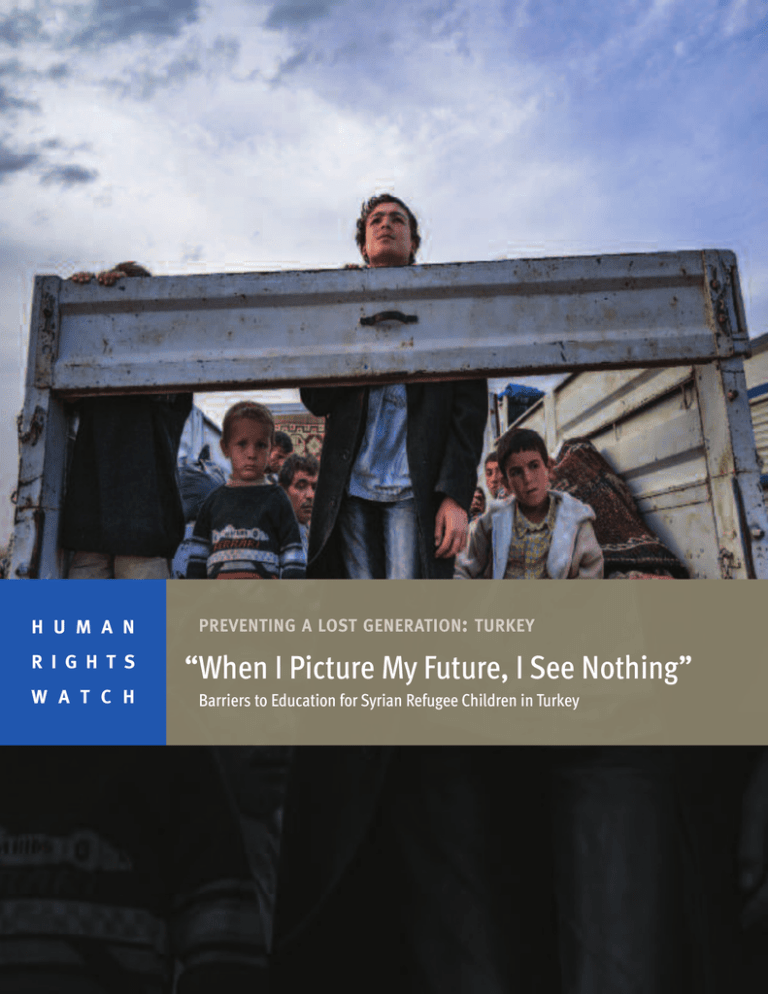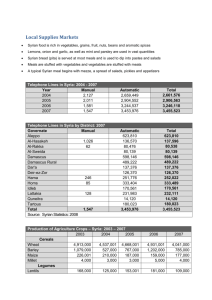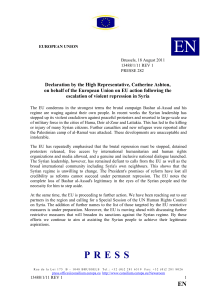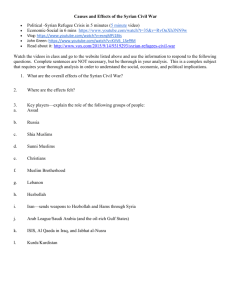“When I Picture My Future, I See Nothing”
advertisement

H U M A N R I G H T S W A T C H PREVENTING A LOST GENERATION: TURKEY “When I Picture My Future, I See Nothing” Barriers to Education for Syrian Refugee Children in Turkey SUMMARY HUMAN RIGHTS WATCH | NOVEMBER 2015 If a person is sick, they can get treatment and get better. If a child doesn’t go to school, it will create big problems in the future—they will end up on the streets, or go back to Syria to die fighting, or be radicalized into extremists, or die in the ocean trying to reach Europe. Shaza Barakat, director of a Syrian temporary education center n Istanbul and mother to a son who died aged 16 in 2012, when he returned to Syria to fight with opposition forces after finding no educational opportunities in Turkey Photographs © 2015 Stephanie Gee/Human Rights Watch Class pictures of Sara, 10, who was the only Syrian student in her class at her local public school in the town of Turgutlu in western Turkey. Sara enjoys attending school so much that when Human Rights Watch met her in June 2015, she had already packed her bags for the new school year, just days after the start of her summer vacation. Now that I can’t go to school, it’s a tough situation. It’s hard to get used to it. I work occasionally, filling in for my sisters at the factory. When I picture my future, I see nothing. Rasha, 16, who was unable to enroll in school when she arrived in Izmir, Turkey, from Qamishli, Syria in August 2013, because she lacked a residency permit. Unable to speak Turkish, she could not join her peers in the 10th grade, and was not allowed to join a lower grade. Abdulmajid, 11, (left) stands next to his brother Mohammed, 9, in a street in the port city of Mersin, southern Turkey. In February 2015, they fled Syria with their family and now work full-time in a tailor’s shop. They have not attended school since 2012. Nine-year-old Mohammed has not attended school since 2012, when an armed group took over his school in the Aleppo countryside. His family, which fled to the Turkish seaside city of Mersin in early 2015, now lives in a small, unfurnished apartment and sleeps on the floor. Mohammed, who would now be in third grade, misses going to school. “I was one of the best in my class, and I really liked learning how to read. But now we don’t even have any books or anything that I can use to study on my own.” He works eleven-hour daily shifts at a garment workshop where he earns 50 Turkish lira (approximately US$18) per week. 4 “WHEN I PICTURE MY FUTURE, I SEE NOTHING” This report is the first of a three-part series addressing the urgent issue of access to education for Syrian refugee schoolchildren in Turkey, Jordan, and Lebanon. The series will examine the various barriers preventing Syrian children from accessing education and calls for host governments, international donors, and implementing partners to mitigate their impact in order to prevent a lost generation of Syrian children. Prior to the conflict, the primary school enrollment rate in Syria was 99 percent and lower secondary school enrollment was 89 percent, with high gender parity. Today, nearly 3 million Syrian children inside and outside the country are out of school, according to UNICEF estimates— HUMAN RIGHTS WATCH | NOVEMBER 2015 Leen, Alaa, and Sidra, three Syrian sisters who came to Turkey in 2013, sit together in their family home in Istanbul. The older two, aged 10 and 9, have been out of school since 2011, while the youngest, 5, has never attended school. They attend part-time Quranic lessons at their local mosque. demolishing Syria’s achievement of near universal education before the war. In Turkey’s 25 government-run refugee camps, approximately 90 percent of school-aged Syrian children regularly attend school. However, these children represent just 15 percent of the Syrian refugee school-aged population in 5 Quranic course books belonging to Syrian refugee Leen, 10, lie on the floor of her home in Istanbul. Leen’s family cannot afford to send her to a Syrian temporary education center and believe she is not permitted to attend a Turkish school, so she attends part-time Quranic lessons at her local mosque. Turkey; 85 percent of Syrian refugee children in Turkey live outside refugee camps in towns and cities. During the 2014-2015 school year, only 24 percent of these school-aged children were enrolled in school. Some children in the 50 families that Human Rights Watch interviewed had lost as many as four years of education, while others, too young for school when the war broke out 6 in 2011, had never set foot in a school building. On average, the children we interviewed had lost two years of schooling. Under international law, the government of Turkey is obligated to provide all children in Turkey with free and compulsory primary education and with access to secondary education. Turkey has taken several positive steps to meet its obligations by lifting legal barriers to Syrian children’s access to public schools. In 2014, for example, the government made its public school system available to Syrian children with government-issued IDs, and began to accredit a parallel system of private “temporary education centers” that offer a Syrian curriculum throughout the “WHEN I PICTURE MY FUTURE, I SEE NOTHING” country approved by the education ministry of the Syrian Interim Government, a cabinet of Syrian opposition authorities in exile in Turkey. It also lifted restrictions that required Syrian children to produce a Turkish residency permit in order to register for school. And it gave refugees free access to emergency healthcare, identity cards indicating their lawful residence in the country, the right not to be detained for their irregular entry to the country, access to family reunification mechanisms, access to legal consultation, and protection from forcible return to Syria. These changes resulted in a marked improvement in school enrollment levels, which by December 2014 had reached 20 percent. HUMAN RIGHTS WATCH | NOVEMBER 2015 A Turkish-language textbook lies on the floor of the home of Syrian refugees. Syrian refugee children enrolled in Turkish public schools study in Turkish, which can be a significant burden for some. However, for all its efforts, Turkey has not yet succeeded in making education available to most Syrian refugee children in Turkey, especially those living outside the camps, and the laudable progress to date should be considered only the beginning of efforts to scale-up enrollment. Overall, less than one-third of the 620,000 Syrian schoolaged children who entered Turkey in the last four years are 7 Maya, 9, reads a school textbook in her family home. She enjoys attending her local public school in Izmir, on Turkey’s west coast, where she is one of four Syrian students in her class. Her favorite subject is art. attending school—meaning approximately 415,000 remain unable to access education. Moreover, this report finds that some Turkish schools have turned away refugee children or failed to reasonably accommodate their needs, and that the private temporary education centers are often overcrowded and unaffordable for refugee families. 8 In addition, despite Turkey’s revised legal framework guaranteeing access to formal education for Syrian refugee children like Mohammed, some Syrian families told Human Rights Watch that Turkish public schools continued to demand they produce documents that are no longer required for enrollment. Human Rights Watch research found that a number of addressable barriers prevent Syrian refugee children in Turkey who live outside refugee camps from attending school, above all: • Lack of information: families lack crucial information on Turkey’s admission procedures. “WHEN I PICTURE MY FUTURE, I SEE NOTHING” • Language barriers: most Arabic-speaking Syrian children face a language barrier in Turkish-language schools. • Economic hardship: lack of money affects families’ ability to pay the costs of transportation, supplies, and—in the case of temporary education enters— tuition. Child labor is rampant among the Syrian refugee population, to whom Turkey does not give work permits due to concerns about the effects on its host unemployed population. As a result, many families are dependent on their children’s income because parents cannot make a fair wage without labor protections. Seventeen of the 30 interviewed families with out-of-school children told Human Rights Watch they relied on those HUMAN RIGHTS WATCH | NOVEMBER 2015 Out-of-school Syrian siblings Mohammed, 11, Sevin, 5, and Barfeen, 13, sit in their home in Izmir, western Turkey, where they have lived since November 2013. They spend their days watching TV and doing housework while they wait for their parents to come home from work. Their mother says the family is “hopeless and desperate to escape Turkey.” children, some as young as eight, to help support the household. For example, Mohammed’s mother told Human Rights Watch that he and his 11-year-old brother were not in school because “we don’t know anything about how to register or if they are allowed to go.” She explained that because her husband does not have a work permit, he 9 • Creating a functional mechanism to monitor school dropouts and encourage attendance; • Investing in training for teachers and school personnel tailored to the unique challenges of educating a non-Turkish speaking refugee population; • Working with implementing partners such as the United Nations International Children's Emergency Fund (UNICEF) and the United Nations High Commissioner for Refugees (UNHCR) to disseminate accurate information to the more than 1.8 million refugees from Syria in Turkey, including those in harder-to-reach areas, regarding the procedures and requirements for school registration. • Improving its temporary protection regime for Syrian refugees by granting them the right to work; • Providing widespread access to lawful work permits for Syrian beneficiaries of the temporary protection regime in order to offer disadvantaged Syrian families access to labor protections and the possibility of steady, minimum-wage work, and in doing so to mitigate the high rate of child labor among Syrian refugee households. Failing to act urgently to ensure Syrian children’s access to education in host countries like Turkey may have a ruinous effect on an entire generation of children like Mohammed. Rawan, 14, holds the certificate she received upon completing the 4th grade at a Syrian temporary education center in Istanbul. She missed nearly four years of school prior to her enrollment in January 2015 spending approximately US$6 billion, with limited support from the international community, which should step up its financial and other support to Turkey. But Turkey too should do more to ensure that its own policies are being enforced, and to address the remaining practical obstacles that prevent ensuring Syrian children’s access to education. This includes: works illegally in a garment factory for wages far below his Turkish co-workers. Her two sons work, she said, because her husband’s income barely covers living expenses and only their basic healthcare costs are covered since he is uninsured. • Implementing accelerated Turkish language programs through the public school system to overcome language barriers for Syrian students; • Ensuring provincial compliance with national directive to address evidence that some public schools are not complying with laws guaranteeing Syrian children’s access to the government school system; Turkey has already shouldered a very substantial burden as the host country for nearly 2 million Syrian refugees, 10 “WHEN I PICTURE MY FUTURE, I SEE NOTHING” Securing their education now will reduce the risks of early marriage and military recruitment, stabilize economic futures by increasing earning potential, and ensure that today’s young Syrians will be better equipped to confront uncertain futures, whether it involves rebuilding their country and rehabilitating Syrian society, or contributing to their communities elsewhere in the world. HUMAN RIGHTS WATCH | NOVEMBER 2015 Khamleen, 14, holds a certificate showing that she finished the 7th grade at her local public school in Izmir, western Turkey, at the top of her class. She said she dreams of being “either a doctor or a Korean pop singer one day.” 11 PREVENTING A LOST GENERATION: TURKEY “When I Picture My Future, I See Nothing” Barriers to Education for Syrian Refugee Children in Turkey Since 2011, more than two million refugees have fled the conflict in Syria into neighboring Turkey. Approximately 708,000 of these refugees are school-aged children who face numerous barriers to education. While the school enrollment rate inside refugee camps is high, most refugees live outside camps. Here the education situation is bleak: only 25 percent of school-aged children were enrolled in formal education in 2014-2015. “When I Picture My Future, I See Nothing” is the first of a three-part series addressing the urgent issue of access to education for Syrian refugee schoolchildren in Turkey, Jordan, and Lebanon. It finds that Turkey has taken crucial steps to provide these children with access to education in recent years, including by revising its legal framework to allow Syrian children to enroll in Turkish public schools. However, practical and systematic obstacles remain. Language barriers, economic hardship that drives children into the workforce, social integration difficulties, and lack of adequate information on enrollment procedures all prevent hundreds of thousands of refugee children from attending school. Human Rights Watch calls on the Turkish government, international donors, and implementing partners to work quickly to mitigate these barriers in order to prevent a lost generation of Syria’s children. hrw.org (above) School supplies belonging to a Syrian refugee child enrolled in her local public school. For Syrian refugee children living in Turkey, regularly attending school can be a source of stability, skill-building, and hope for the future ©2015 Stephanie Gee/Human Rights Watch (front cover) SEPTEMBER 2014. Syrian Kurdish refugees look out from the back of a truck as they enter Turkey from the town of Kobane (Ayn al-Arab), Syria, and surrounding villages. © 2014 Michael Christopher Brown/Magnum



